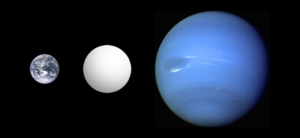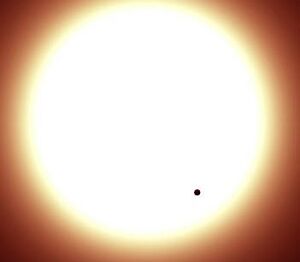CoRoT-7b facts for kids

Size comparison of CoRoT-7b (center) with Earth (left) and Neptune (right)
|
|
| Discovery | |
|---|---|
| Discovered by | Rouan et al. (CoRoT) |
| Discovery site | Polar orbit |
| Discovery date | February 3, 2009 |
|
Detection method
|
Transit |
| Orbital characteristics | |
| 0.0172 ± 0.00029 AU (2.573 ± 0.043 million km; 1.599 ± 0.027 million mi) | |
| Eccentricity | 0 |
| 0.853585 ± 0.000024 d (20.48604 ± 0.00058 h) | |
| Inclination | 80.1 ± 0.3 |
| Star | CoRoT-7 |
| Physical characteristics | |
|
Mean radius
|
0.14 RJ 1.58 ± 0.1 R⊕ |
| Mass | 6.06+0.65−{{{2}}}M⊕ |
| Temperature | 1,300–1,800 K (1,030–1,530 °C; 1,880–2,780 °F) |
CoRoT-7b (also called CoRoT-Exo-7b) is an exoplanet. An exoplanet is a planet that orbits a star outside our Solar System. This planet orbits the star CoRoT-7. This star is located in the constellation of Monoceros, about 489 light-years from Earth.
Scientists first found CoRoT-7b in February 2009. They used a method called transit photometry. This method looks for slight dimming of a star's light. This dimming happens when a planet passes in front of it. For a while, CoRoT-7b was the smallest exoplanet ever found with a measured size. It is about 1.58 times wider than Earth. This means it has almost four times Earth's volume. It was also the first possible rocky planet found outside our solar system.
CoRoT-7b orbits its star very, very closely. It takes only about 20 hours to complete one orbit. Because it is so close, it is extremely hot. Scientists have measured its size and mass. Its density is similar to Earth's. This tells us that CoRoT-7b is a terrestrial planet (rocky planet) like Earth. It is not a gas giant like Jupiter. Scientists also found another planet in this system, CoRoT-7c. It is a "super-Earth" with a mass about 8.4 times that of Earth.
Contents
How CoRoT-7b Was Found
CoRoT-7b was discovered by watching its parent star. The star's light dimmed a little bit every time the planet passed in front of it. This is called a "transit." By measuring how much the light dimmed, scientists could figure out the planet's size. This method is known as the transit method.
The CoRoT space mission, led by France, watched the star CoRoT-7. This happened from October 2007 to March 2008. During this time, the mission recorded 153 times when the star's light dipped. Each dip lasted about 1.3 hours. After about 40 days, a special computer program noticed the faint signal from CoRoT-7b. This led to more observations from telescopes on Earth. These observations helped confirm that it was indeed a planet.
The discovery of CoRoT-7b was announced on February 3, 2009, in Paris. The findings were published in a science journal called Astronomy and Astrophysics.
Measuring Its Mass
After finding CoRoT-7b by its transits, scientists needed to measure its mass. They used a tool called the HARPS spectrograph. This tool helps measure a star's "wobble." A star wobbles slightly because of the gravity of orbiting planets. This method is called the radial velocity method.
Measuring CoRoT-7b's mass was tricky. The star CoRoT-7 is very active, which made the measurements difficult. Early studies gave different mass estimates. Some suggested it was about 4.8 times Earth's mass. Others said it could be around 6.9 or even 8 Earth masses.
Despite the challenges, most studies agree that CoRoT-7b is a rocky planet. Its density is similar to Earth's. Some scientists even think it might have a large iron core, like Mercury.
Spitzer Telescope Observations
The Spitzer telescope, which is in space, also helped confirm CoRoT-7b's existence. Spitzer observed the planet's transits at different light wavelengths. These observations matched what the CoRoT mission saw. This independent confirmation helped scientists be very sure that CoRoT-7b is a real planet. It also helped, because the radial velocity data was a bit "noisy" due to the star's activity.
What CoRoT-7b is Like
CoRoT-7b's mass is about 6.06 times the mass of Earth. Its size and orbit are very well known. It is about 1.58 times the radius of Earth. It orbits incredibly close to its star, much closer than Mercury is to our Sun. One year on CoRoT-7b lasts only about 20 hours. When it was found, it had the shortest known orbit of any planet.
Because it is so close to its star, CoRoT-7b is extremely hot. Its surface temperature can reach between 1300 and 1800 degrees Celsius (2370-3270 degrees Fahrenheit). This heat means the planet might be covered in lava. Scientists believe it is a rocky planet, similar to Earth in composition.
It's very likely that CoRoT-7b is "tidally locked" to its star. This means one side of the planet always faces the star, like our Moon always shows us the same face. The side facing the star would be super hot, possibly with oceans of lava. The side facing away would be much colder and might have solid rock.
Scientists have even suggested that CoRoT-7b could be a "chthonian planet." This is a planet that used to be a gas or ice giant, but lost most of its outer layers due to being so close to its star. However, other scientists think it has always been a rocky planet.
If CoRoT-7b's orbit is not perfectly round, the star's gravity could cause strong tidal heating. This would create intense volcanic activity, similar to what we see on Io, one of Jupiter's moons.
Scientists have called CoRoT-7b the first "lava-ocean planet." This is because its dayside is likely covered in molten rock.
Inside CoRoT-7b
Scientists have created models of what CoRoT-7b might be like inside. If it has about 5 times Earth's mass, it likely has a mantle that moves slowly, like thick syrup. It might also have a small core.
On the super-hot dayside, the surface itself might be part of this slow-moving mantle. This would mean the entire dayside is covered in lava oceans. On the cooler nightside, a solid crust might form. However, there could still be pools of lava and intense volcanism due to the heat from inside.
Scientists also think that CoRoT-7b's core is solid iron. This means it probably does not have its own magnetic field, unlike Earth.
Possible Atmosphere
Because CoRoT-7b is so hot, any gases or liquids on its surface would have evaporated a long time ago. However, the extreme heat might cause the rock itself to vaporize. This could create a very thin atmosphere. This atmosphere might be made mostly of elements like sodium, oxygen, and silicon monoxide.
Other elements like magnesium, aluminium, calcium, silicon, and iron might form mineral particles. These particles could then "rain" out of the atmosphere on the dayside.
Scientists have used powerful telescopes to look for signs of an atmosphere around CoRoT-7b. They looked for specific light patterns from elements like calcium and sodium. So far, they haven't found any clear signs of these elements. This suggests that if CoRoT-7b has an atmosphere, it is very thin and made of rocky vapors. This also means CoRoT-7b is very different from any rocky planet in our own Solar System.
See also
 In Spanish: COROT-7b para niños
In Spanish: COROT-7b para niños
- Chthonian planet
- CoRoT-7c: another close-orbiting super-Earth
- Gliese 1214 b, another exoplanet with a well-known size and mass
- High Accuracy Radial Velocity Planet Searcher or High Accuracy Radial Velocity Planet Search
- Kepler-10b, another exoplanet found to be rocky
- Spitzer Space Telescope or SST
Images for kids




